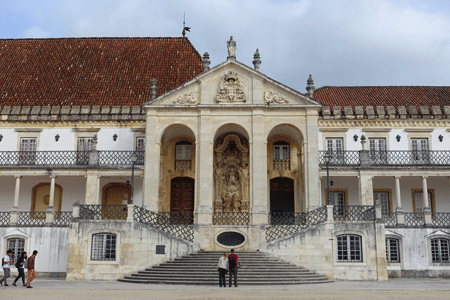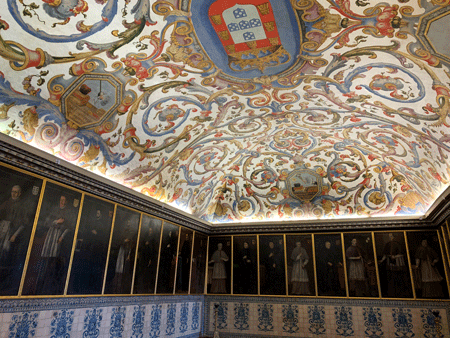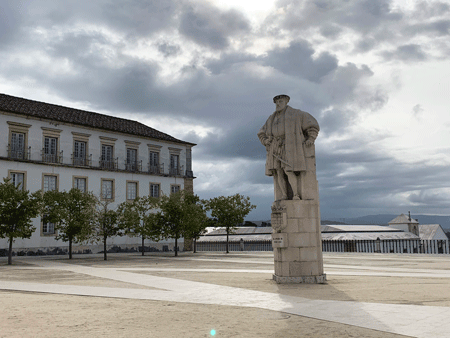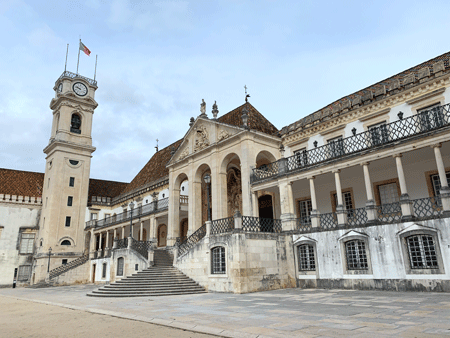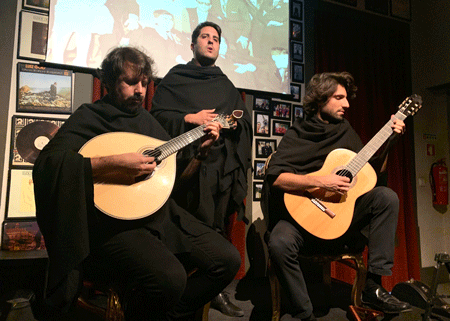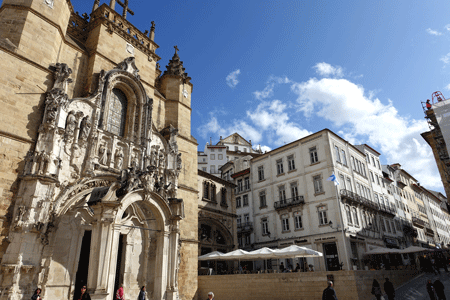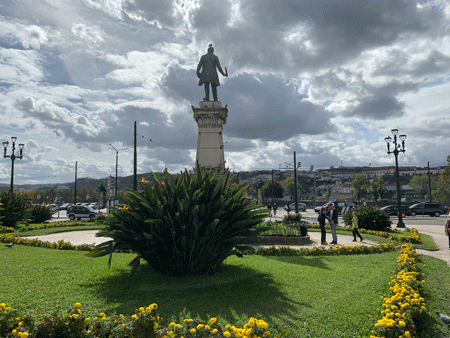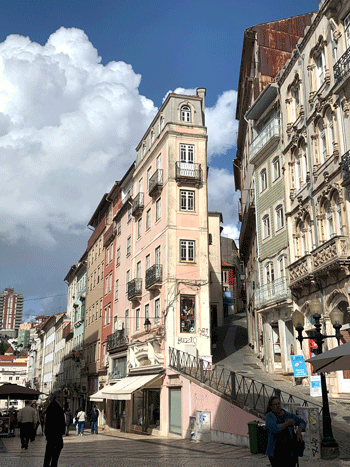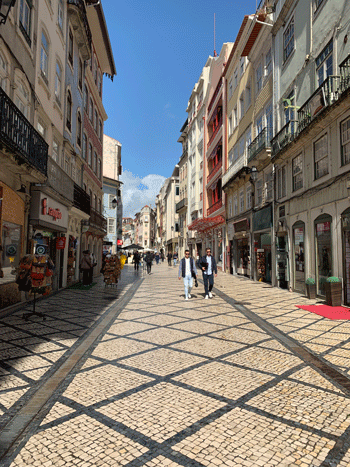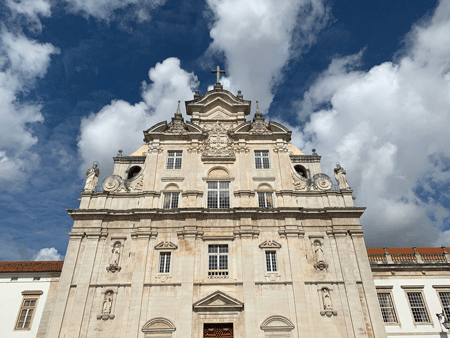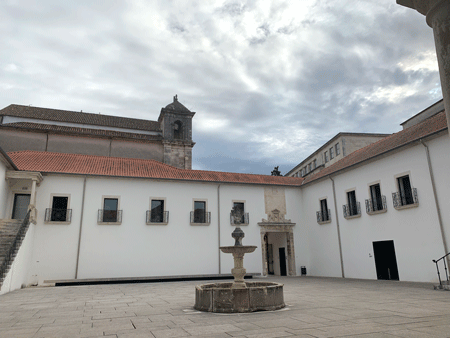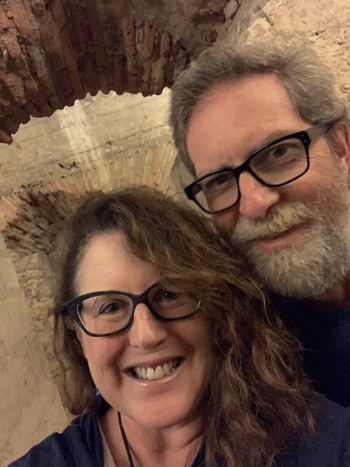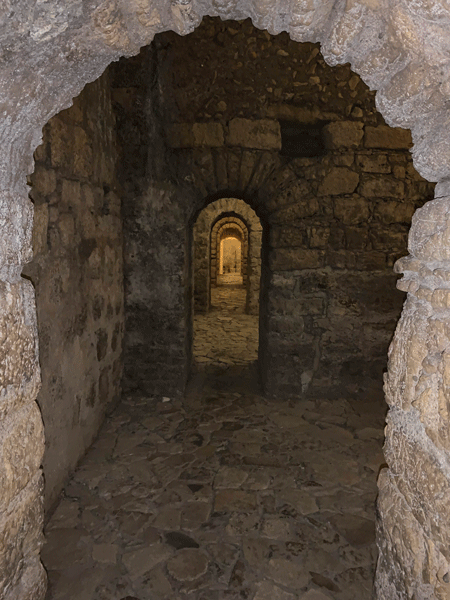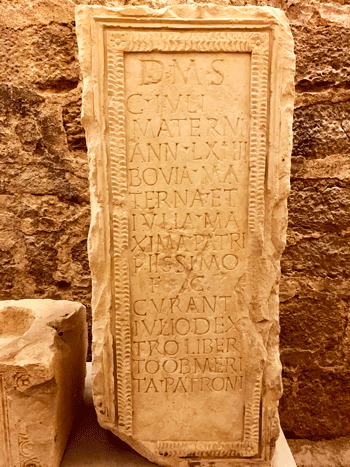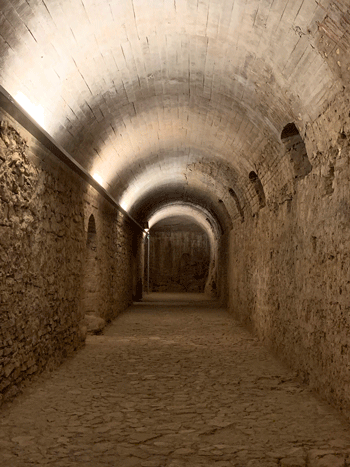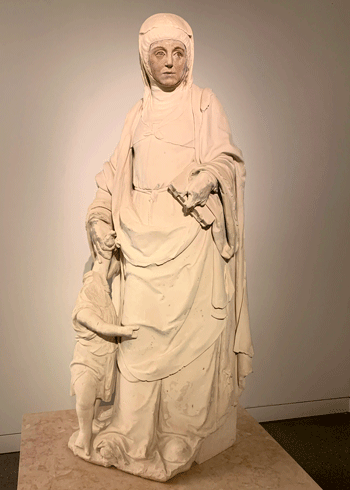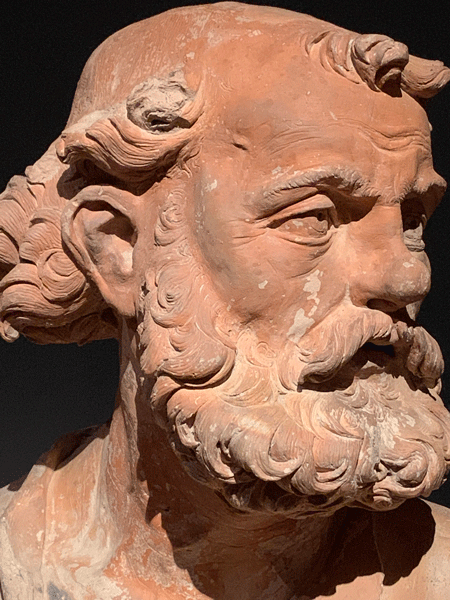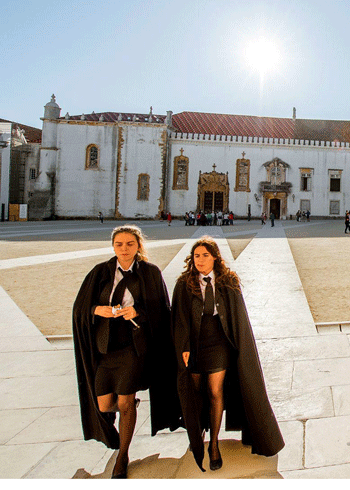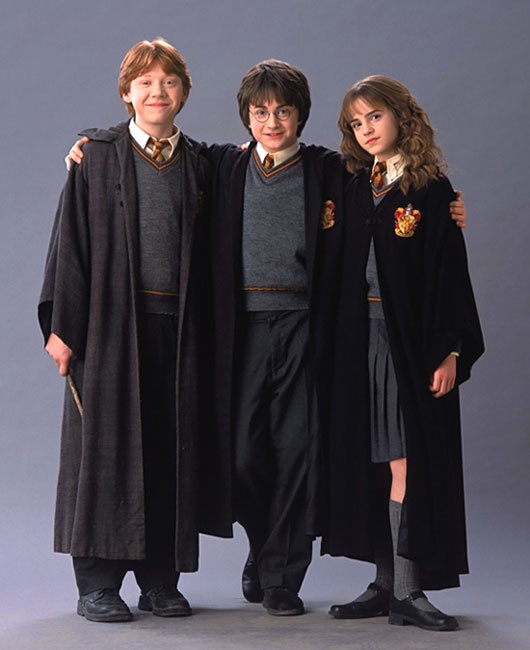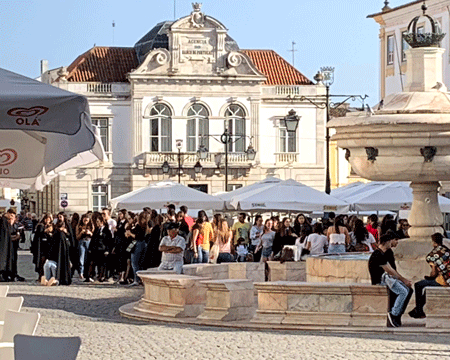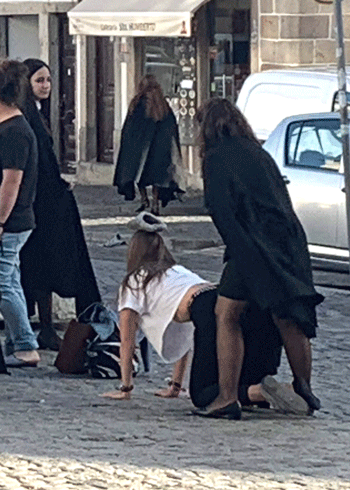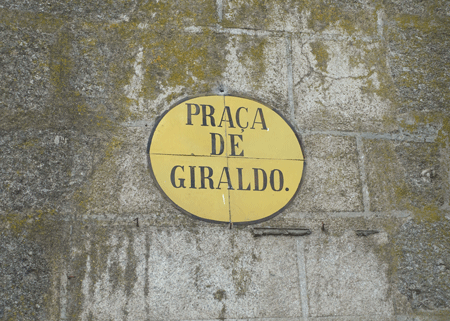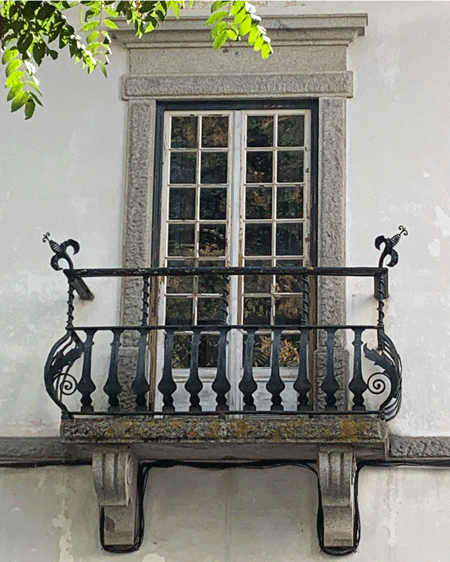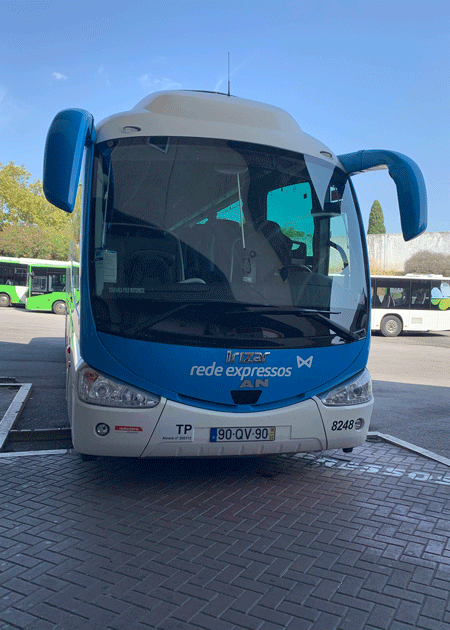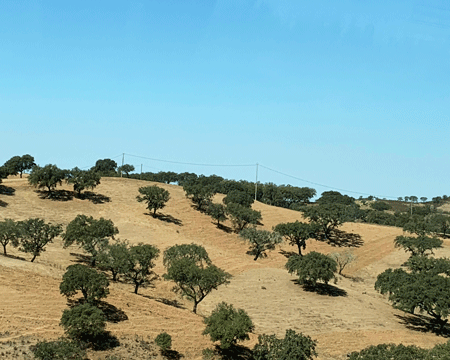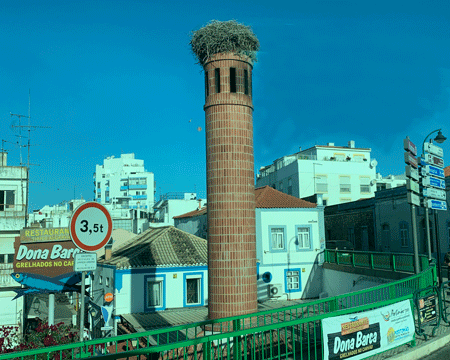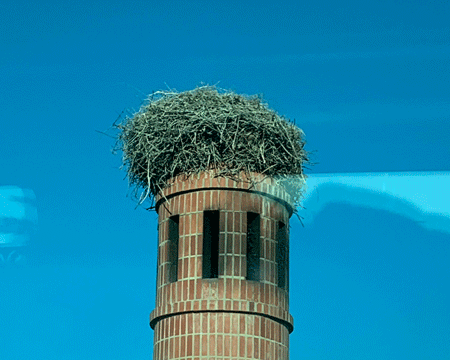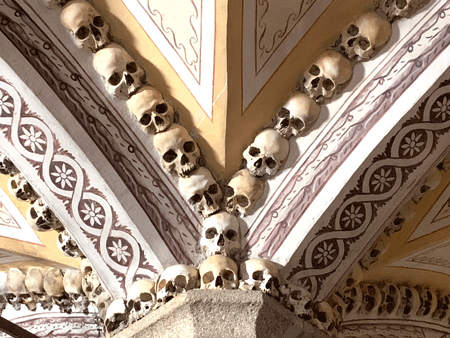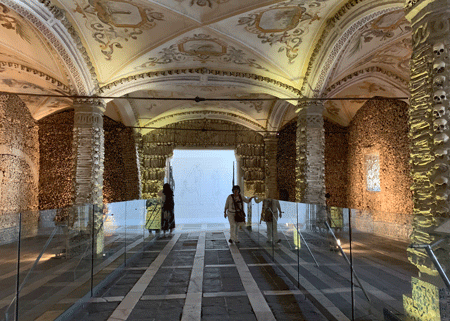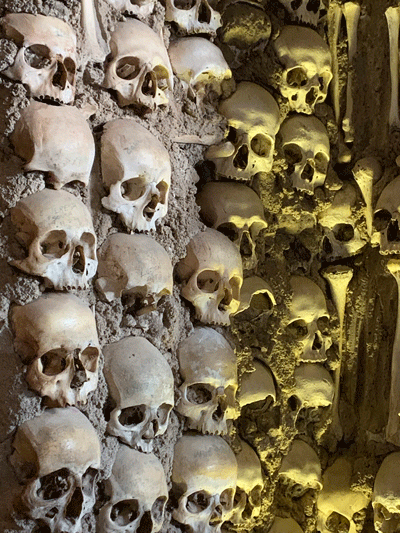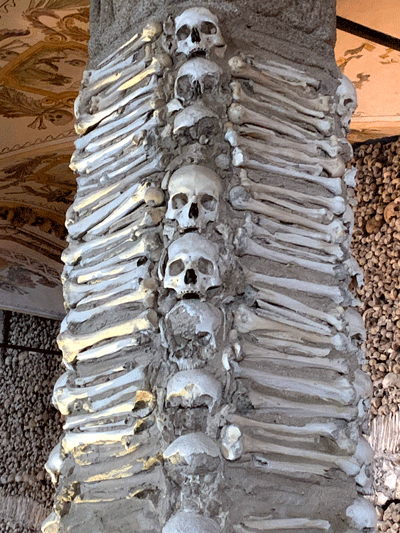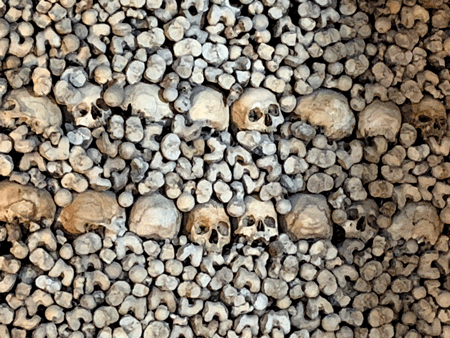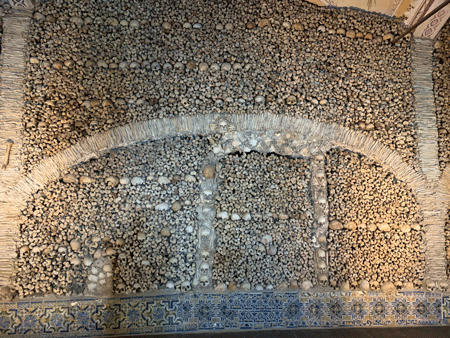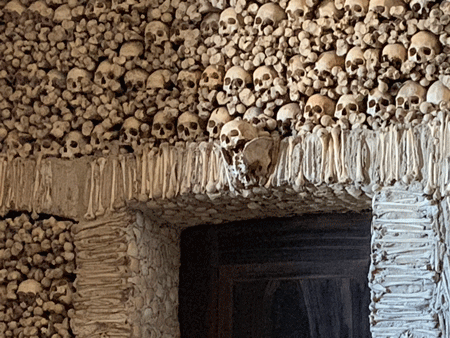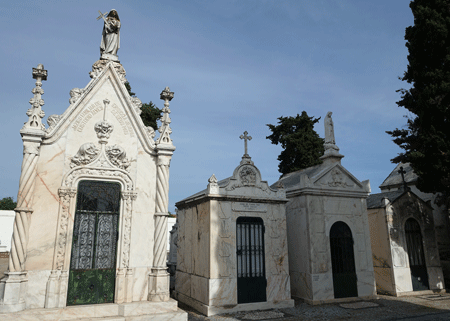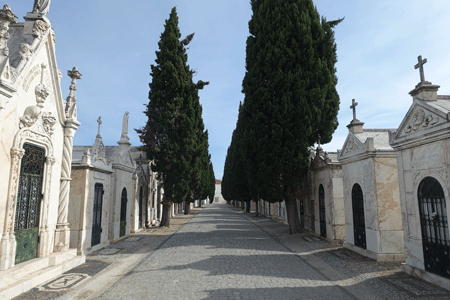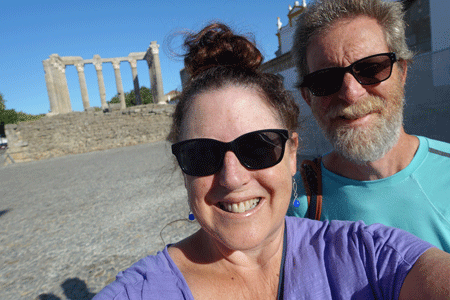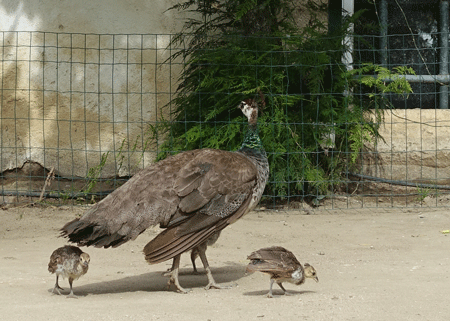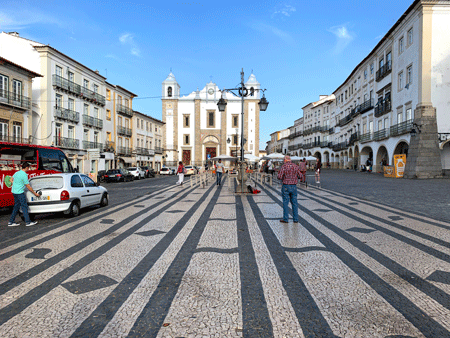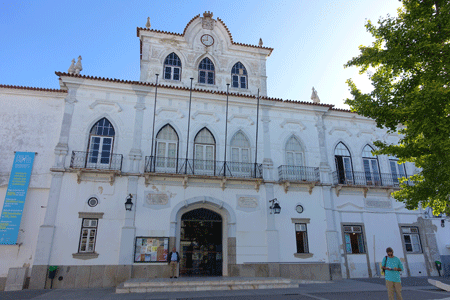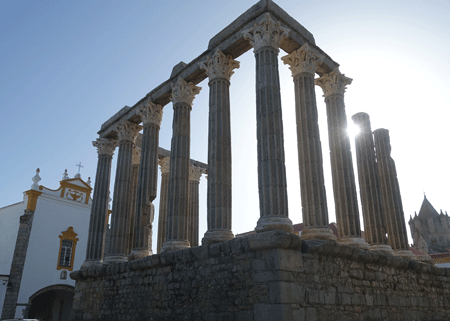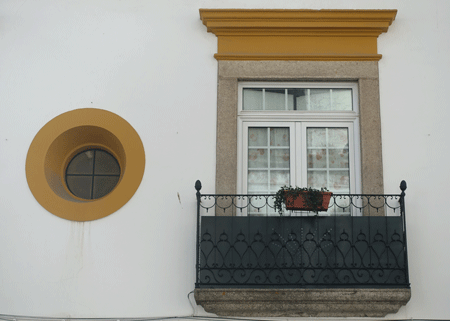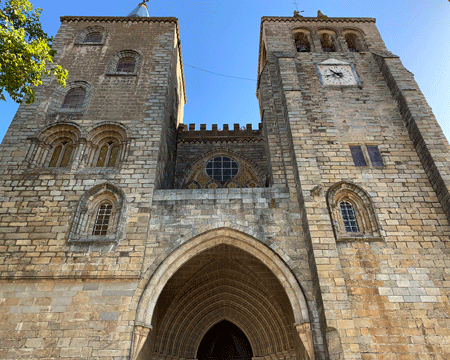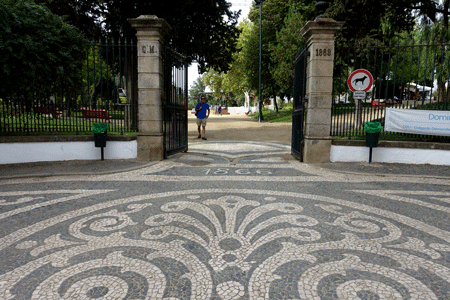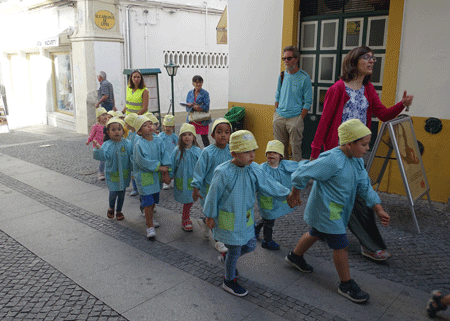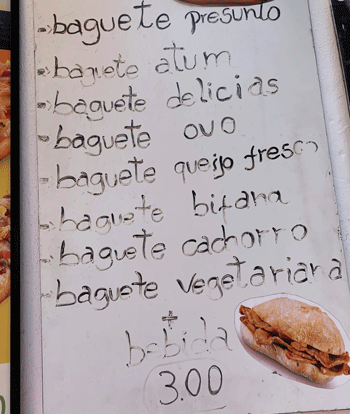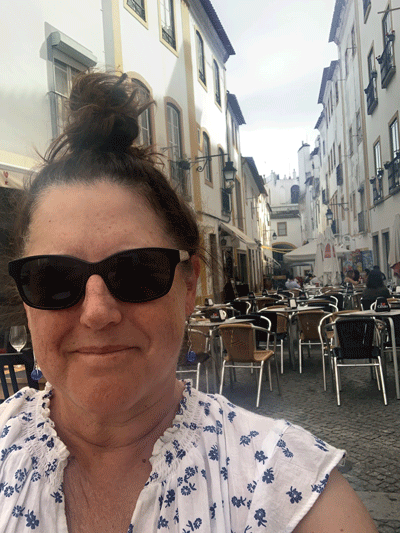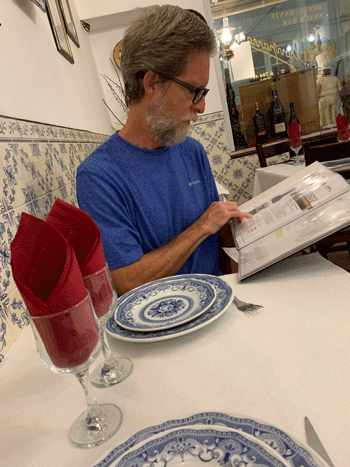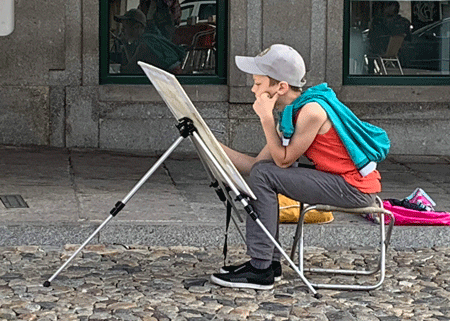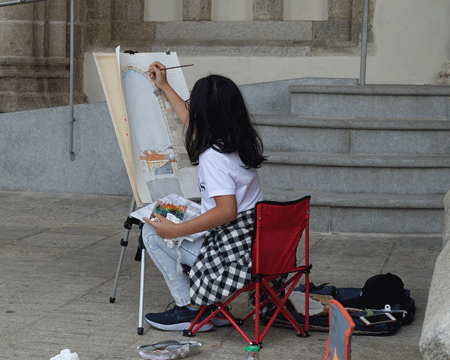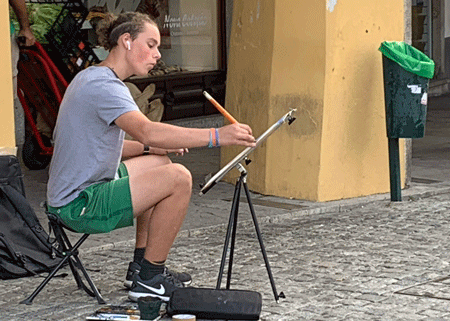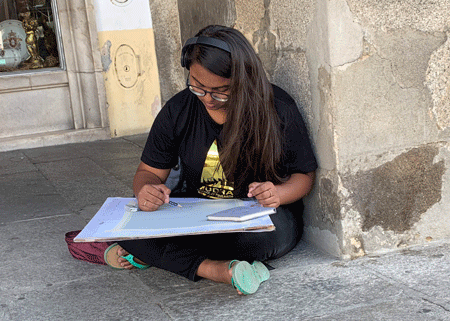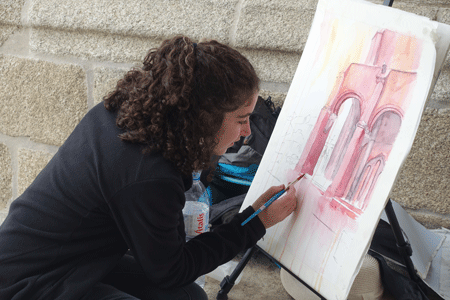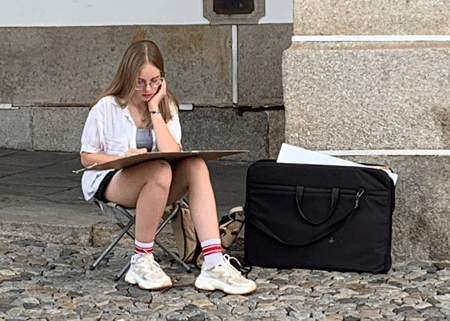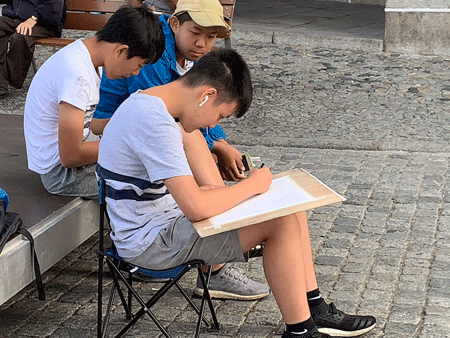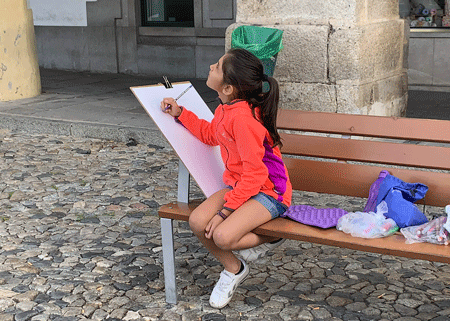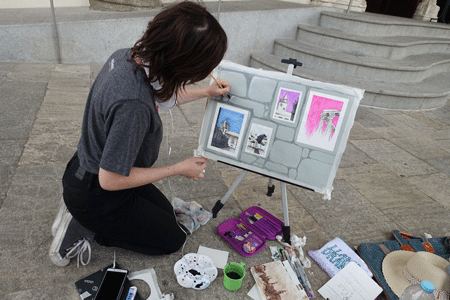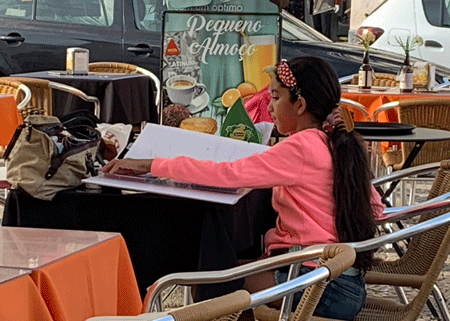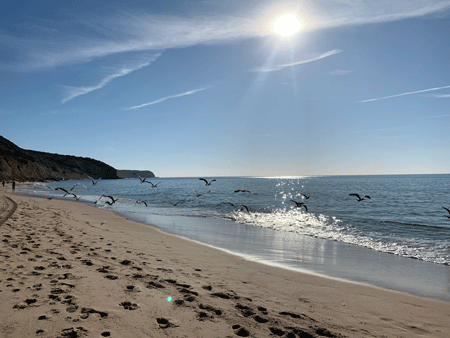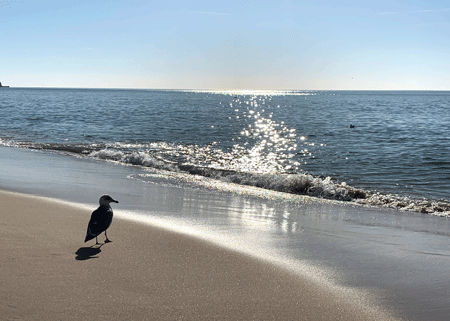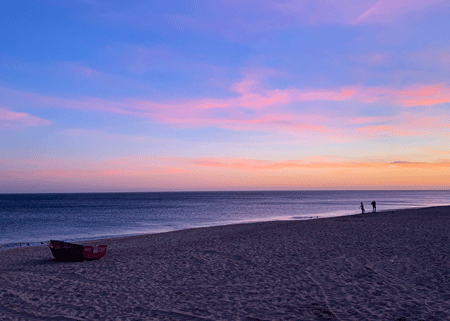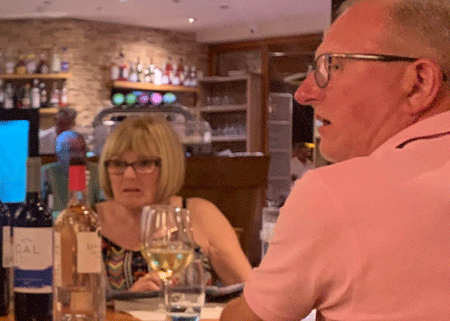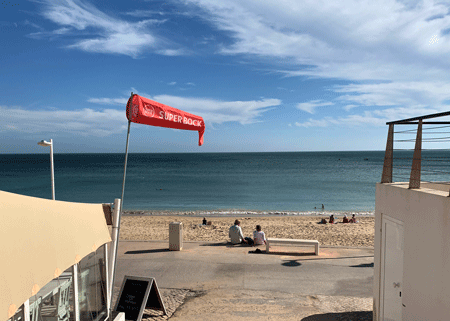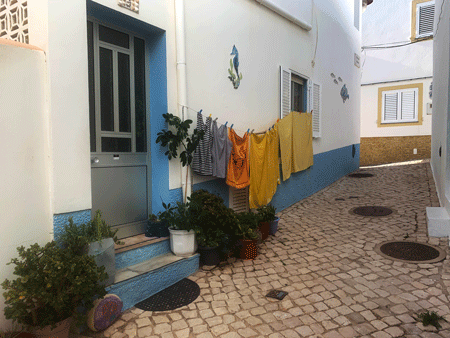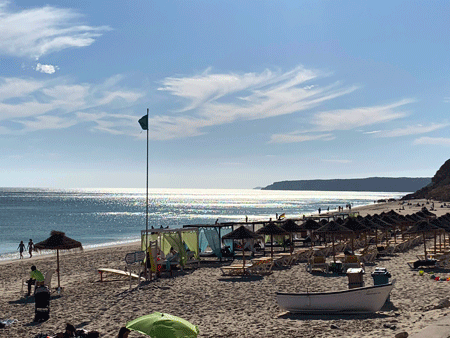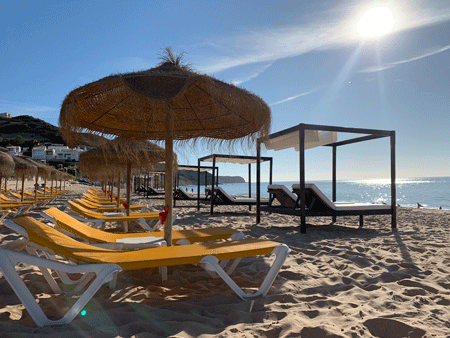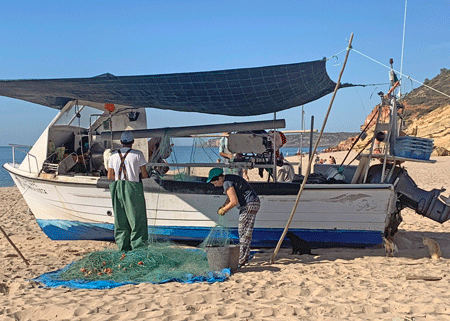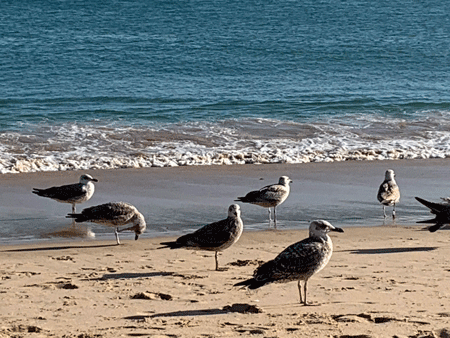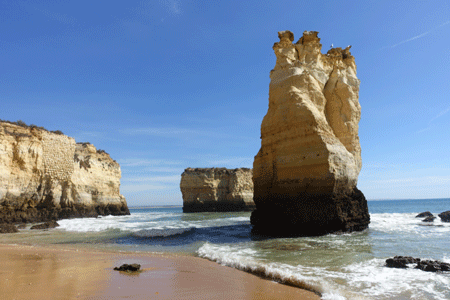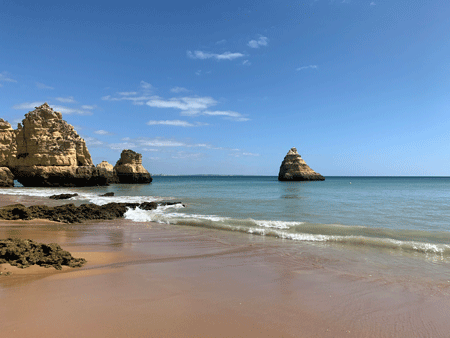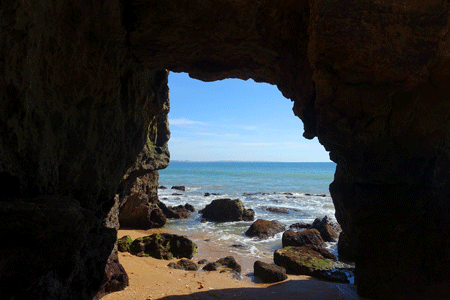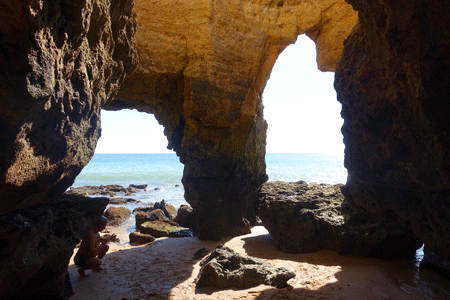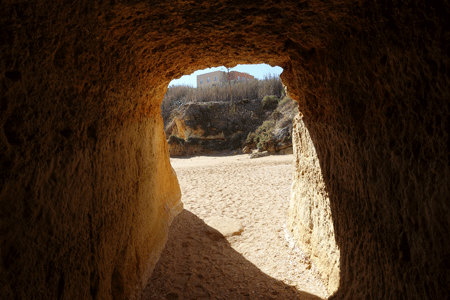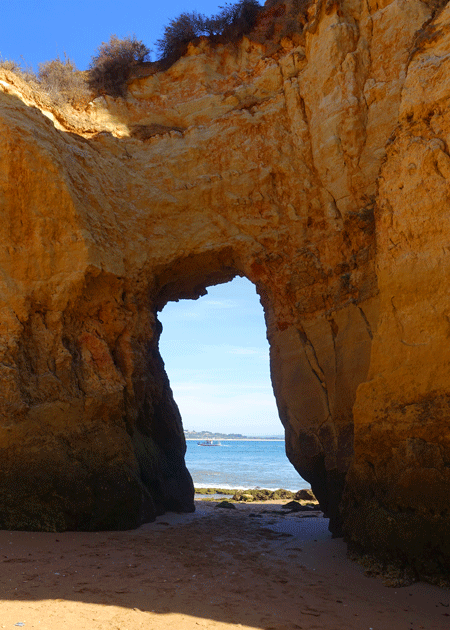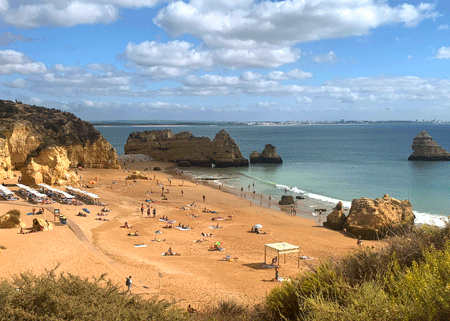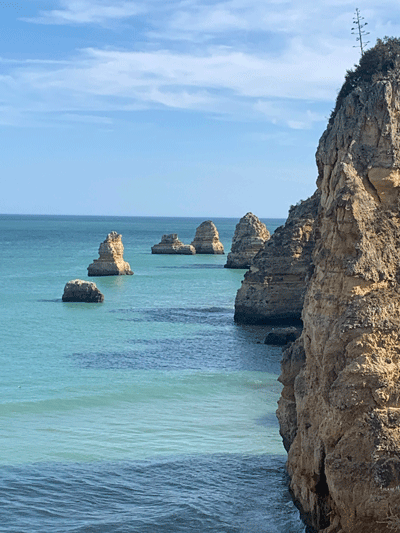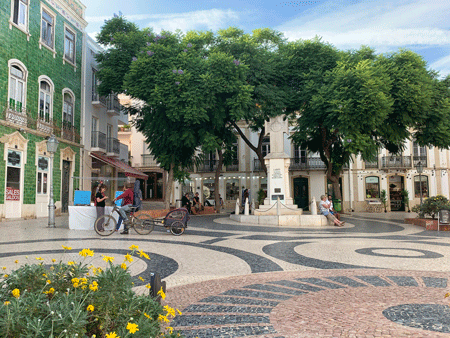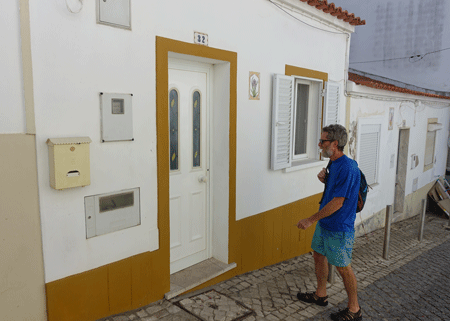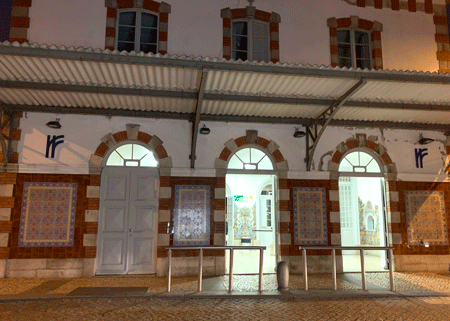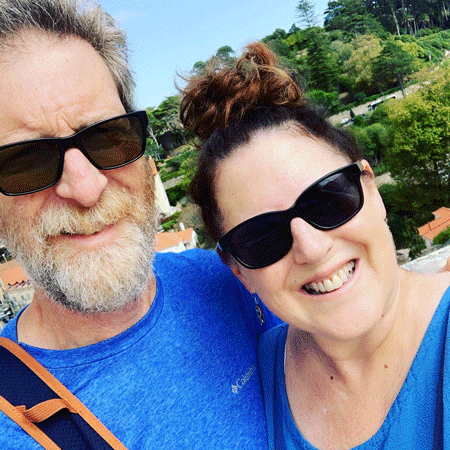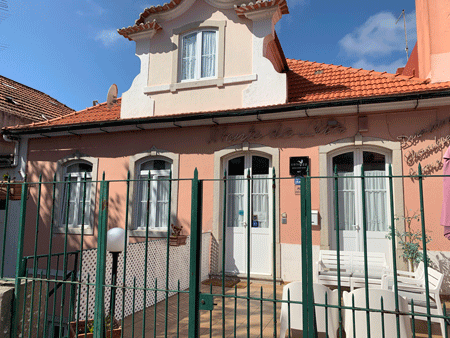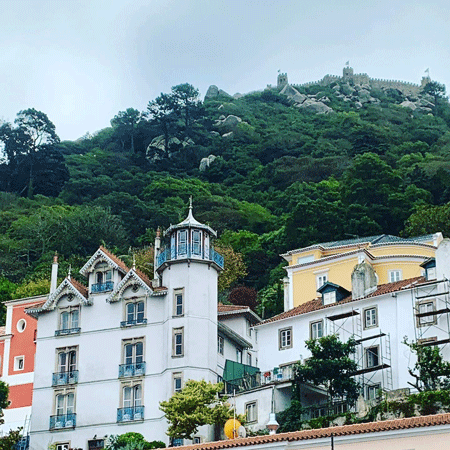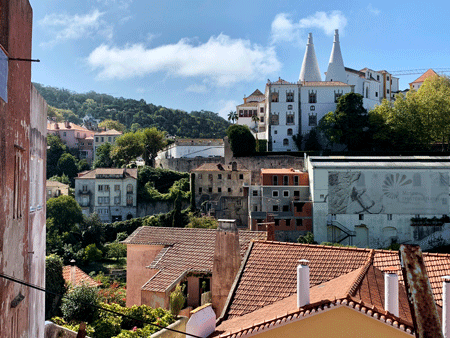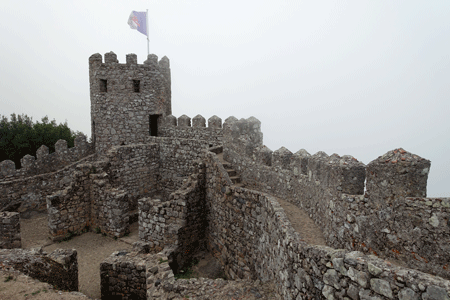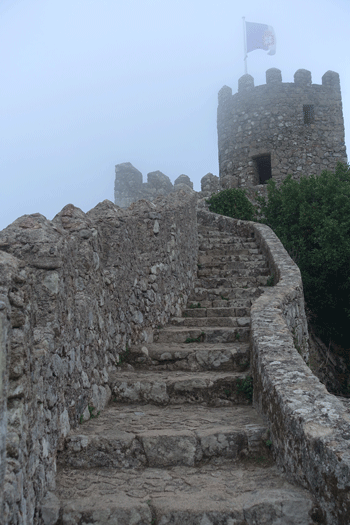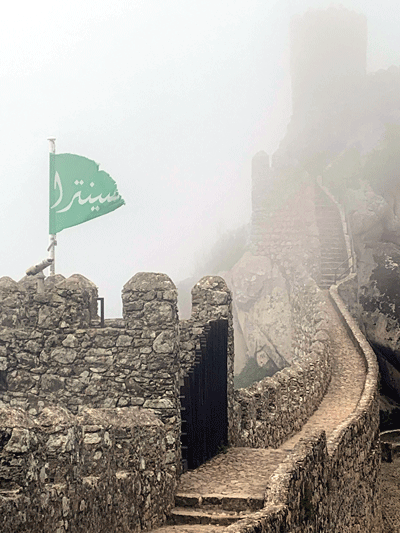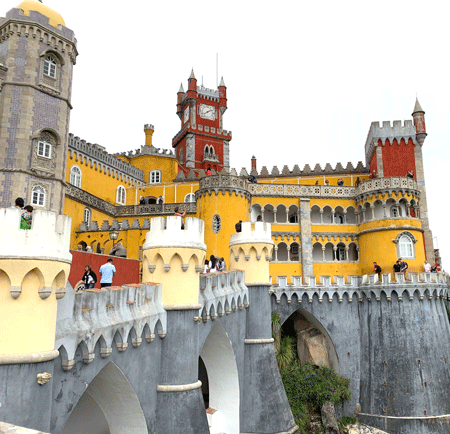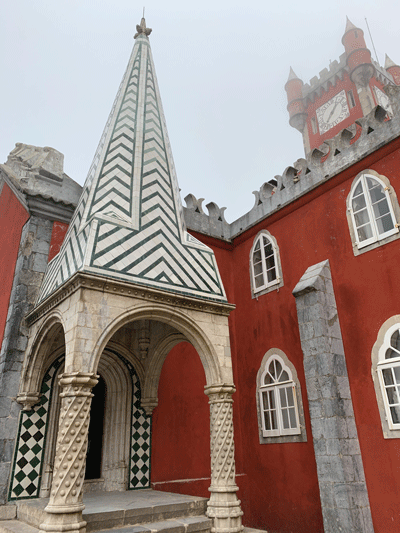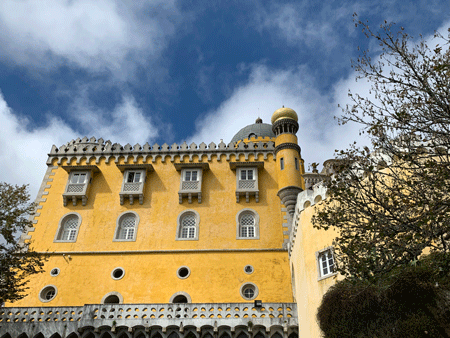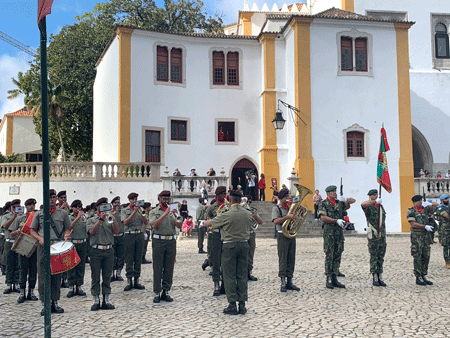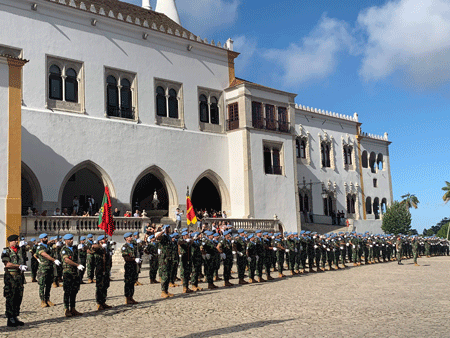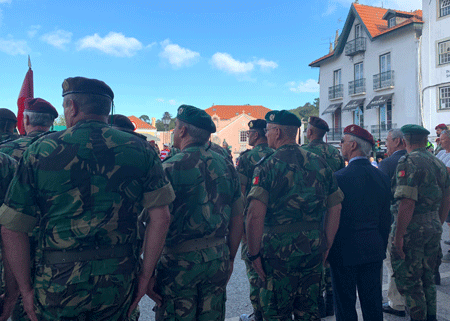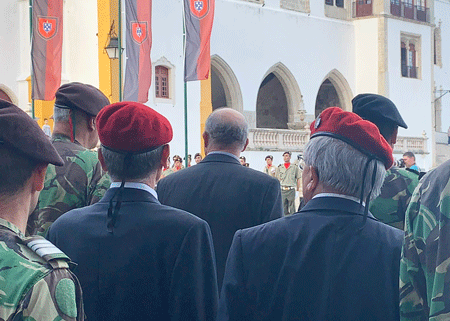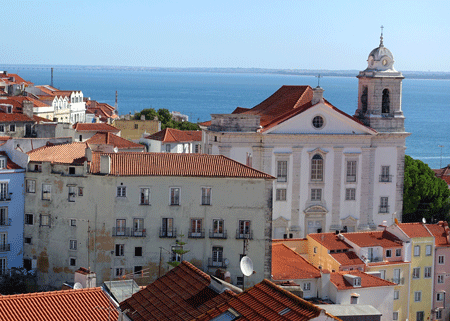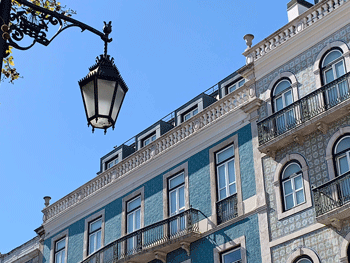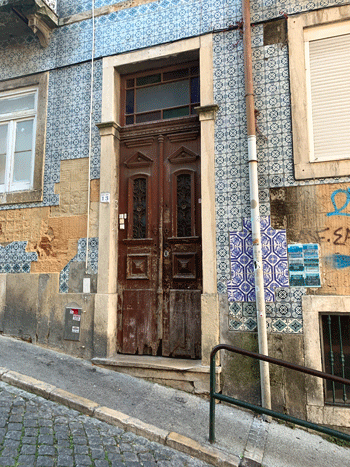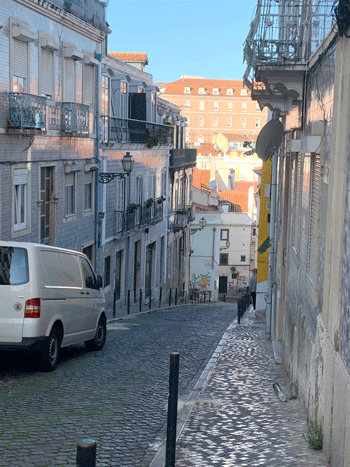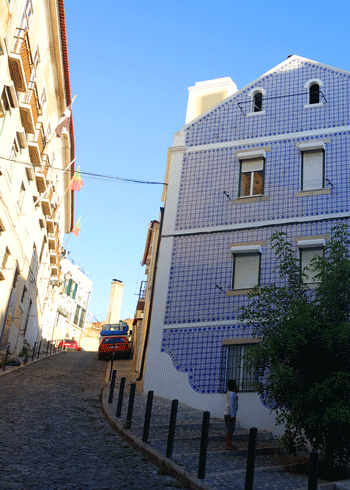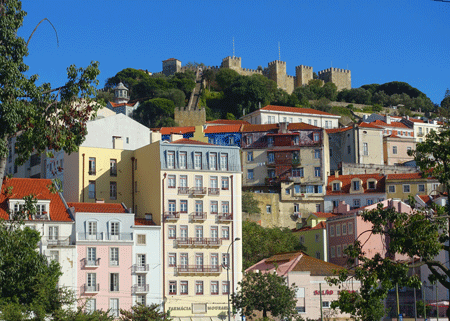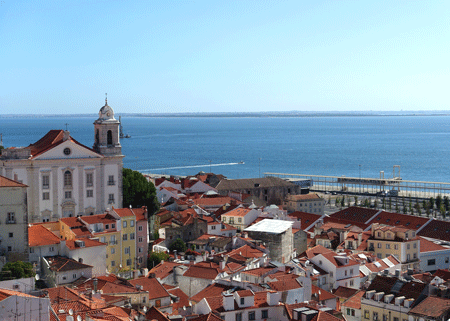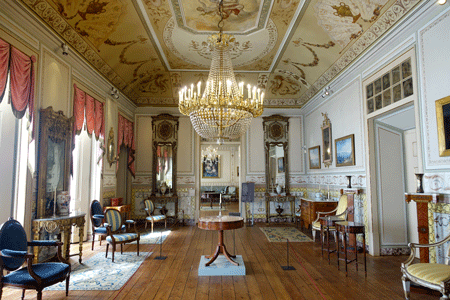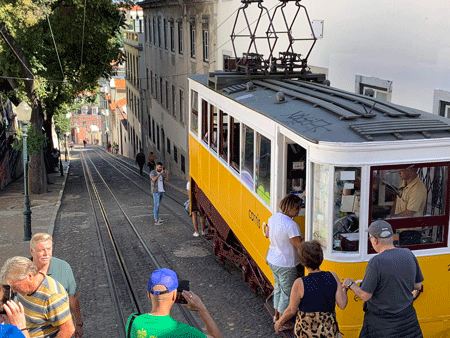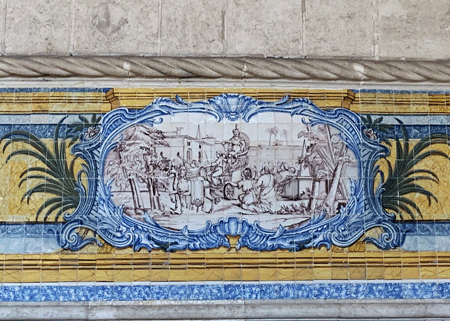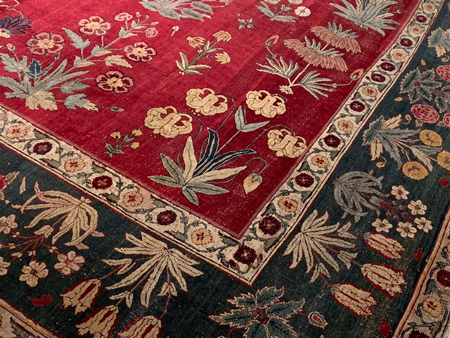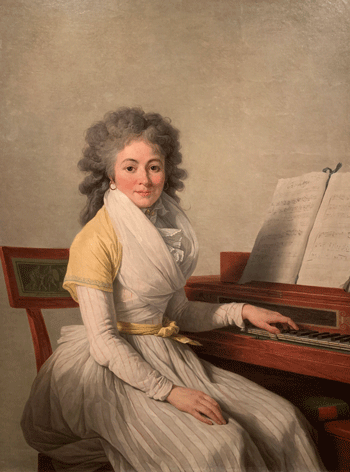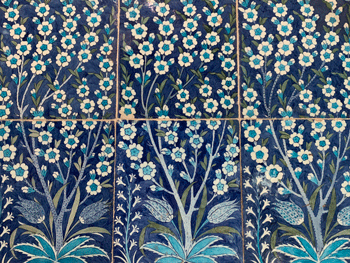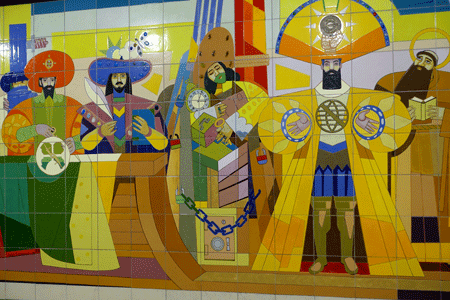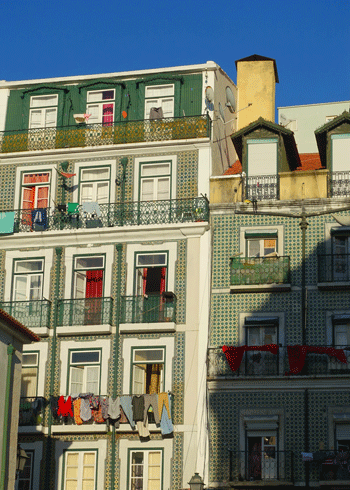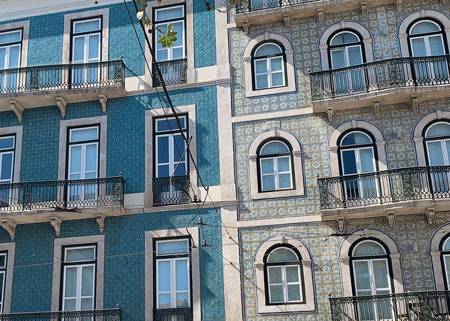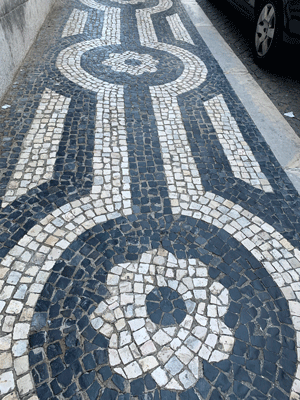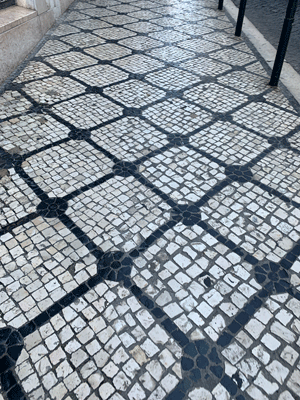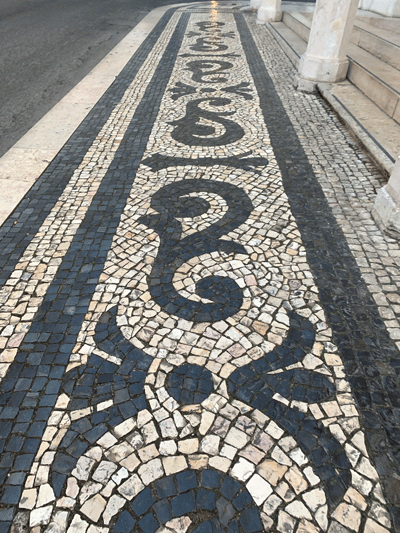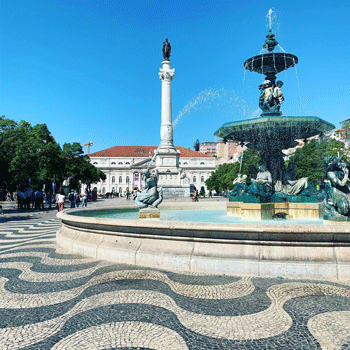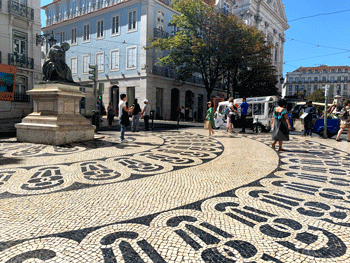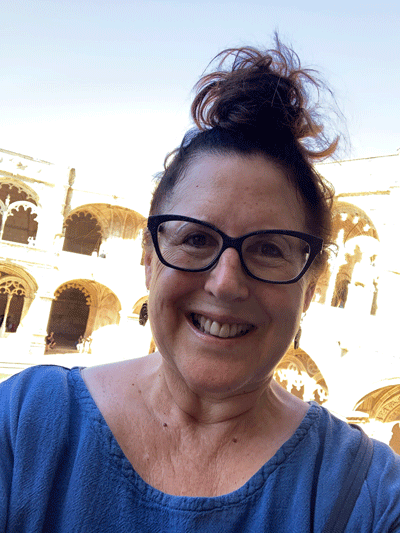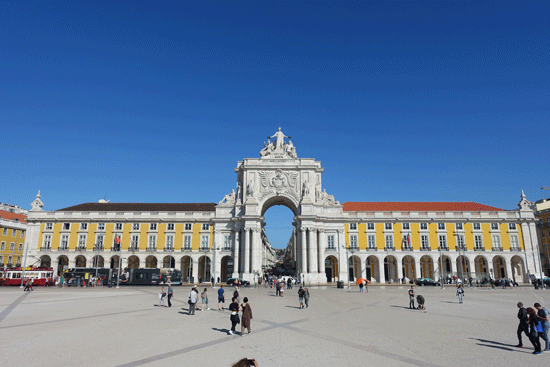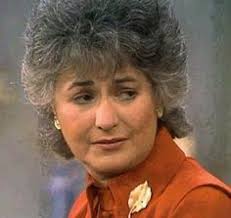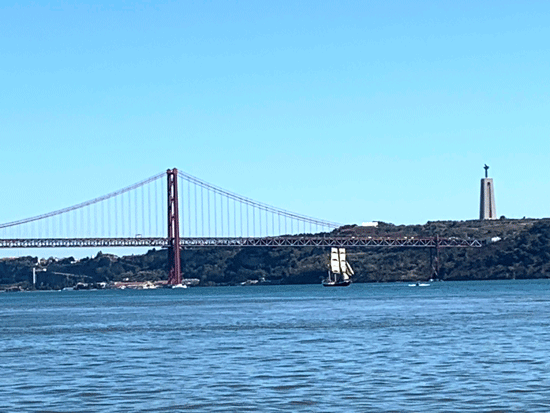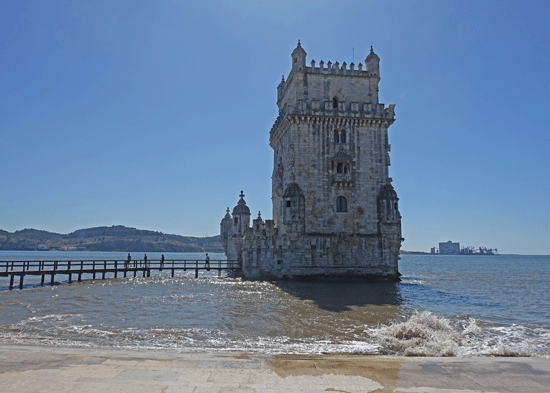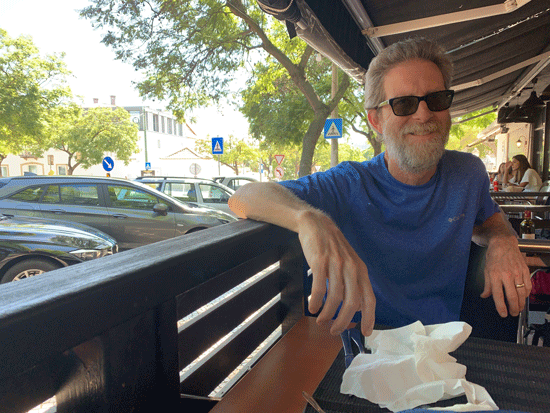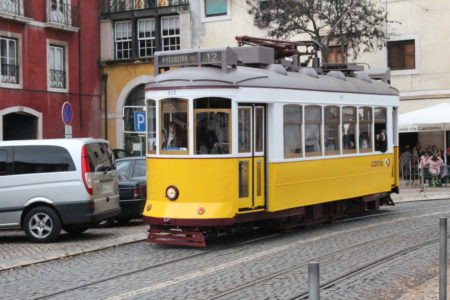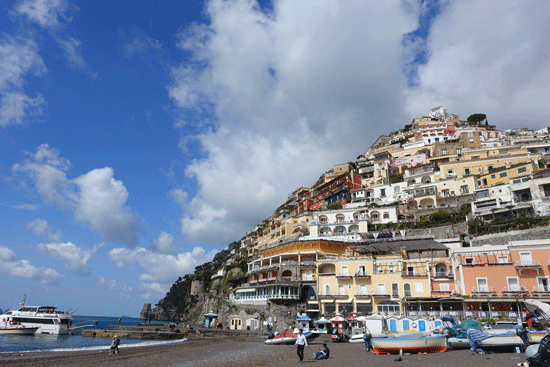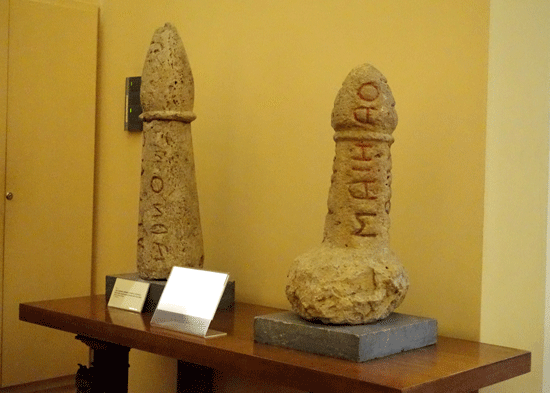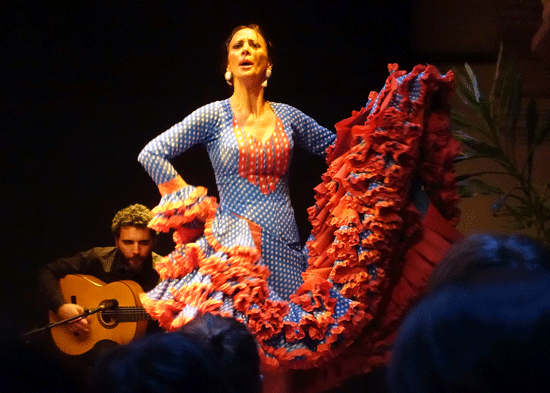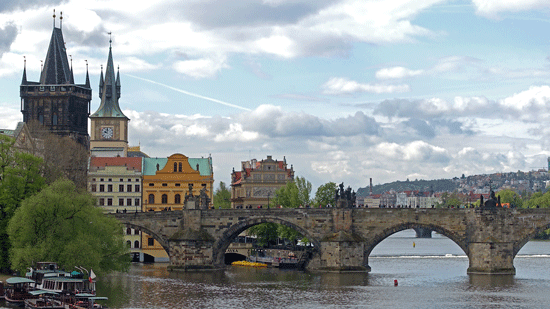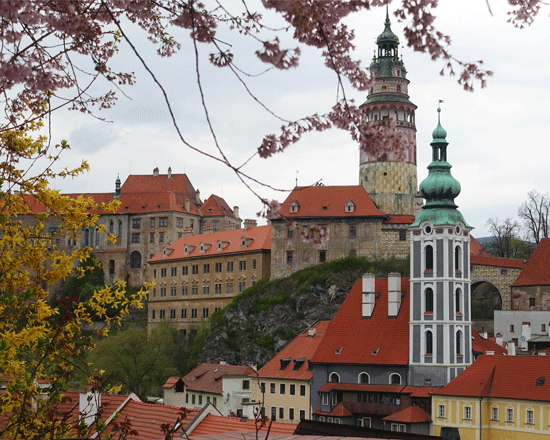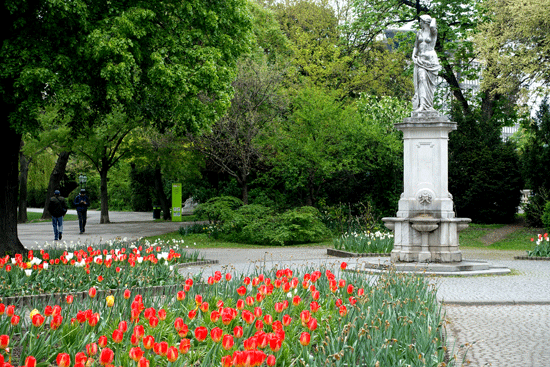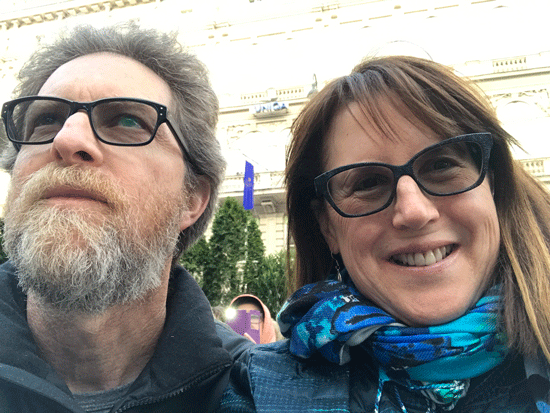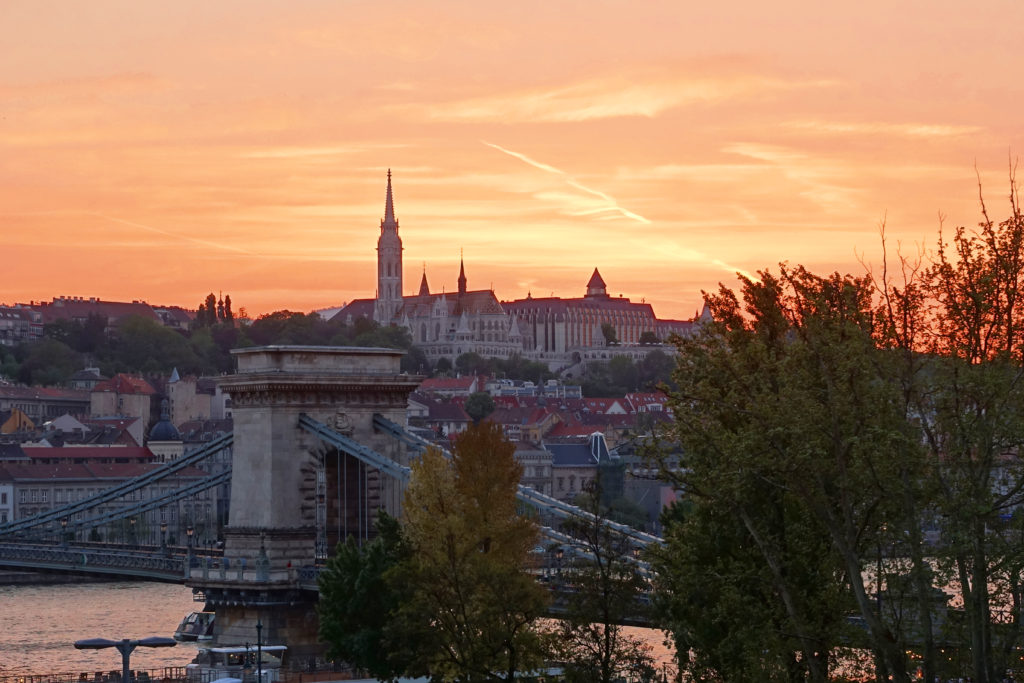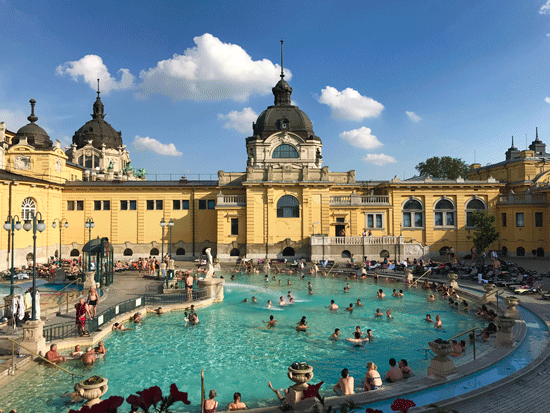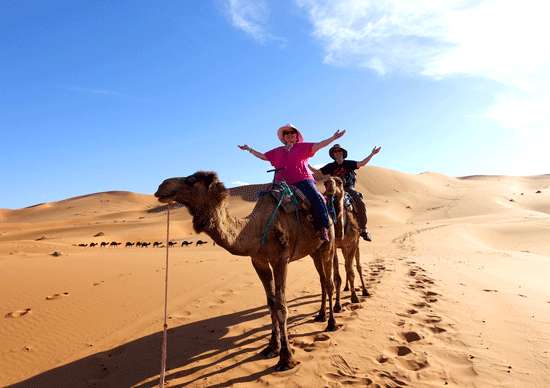Posted October 20, 2019
City of Seven Hills
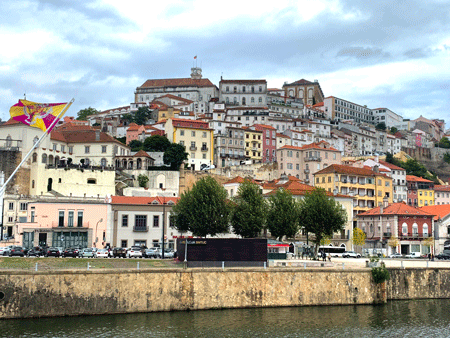
I’m not sure why Lisbon is called the city of seven hills, it certainly doesn’t have anything on Coimbra, or any other Portuguese city we’ve been to. I think the entire country is built on a steep slant, and my thighs, calves, and especially my knees, will attest to that.
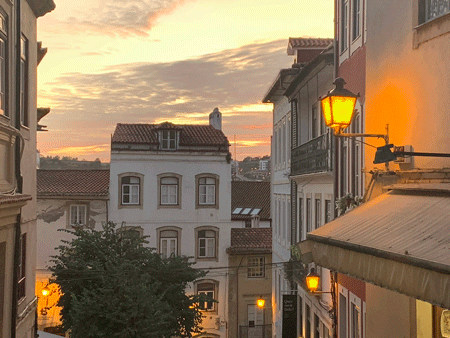
Thankfully, every hill is worth climbing because around every corner there’s a charming square, a breathtaking view, or a quaint cobblestone street filled with colorful tiled homes, four-stories high.
Even our apartment, which was at the top of a huge hill, had its own mini-hill at the door. The foyer sat a good three feet above street level. Someone had placed two large, uneven stone blocks in front of the doorway, masquerading as stairs.
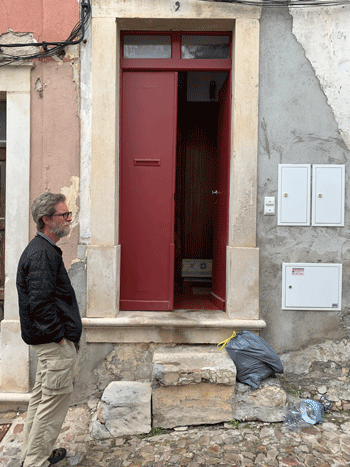
Giant, uneven stone “steps” to apartment 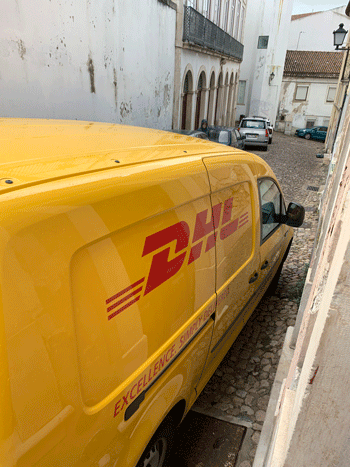
View of a van going by our front window
Ready, Set, Climb
I’d take a deep, cleansing breath, then focus and hoist myself up the uneven stone blocks. It didn’t help that I’m still nursing a bad knee (see Tomar post).
And while I was heaving myself up the stone chunks, cars, vans, and the occasional mini-bus would barrel down the extremely narrow cobblestone lane. The vehicles barely fit down the lane, and would be so close on each side that I’d have to stay tight up against the house, or risk getting flattened.
It Just Works
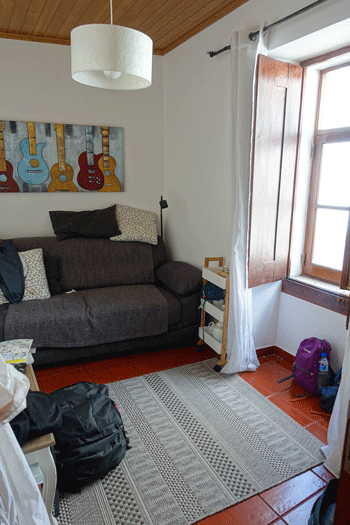
Living Room 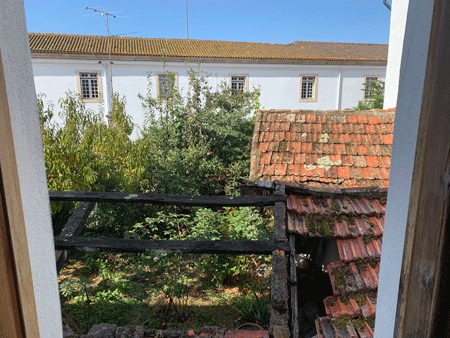
Bedroom Window View 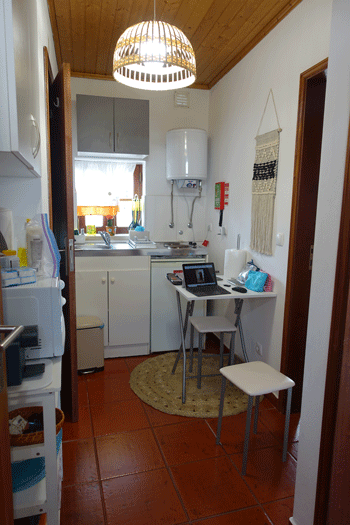
Kitchen
That being said, our apartment was perfect for us in every other way. We had a light-filled bedroom, a tiny, but functional kitchen & bathroom, and a comfortable living room area. And at the bargain rate of $47 a night, we were quite happy.
The University
With our apartment being at the mid-point of the hill in the historic center of Coimbra, half the tourist attractions were up, and the other half were down.
One destination on everyone’s list is the University of Coimbra. We hiked 15 minutes up to the University, where we bought a ticket to tour the the University and the Biblioteca Joanina (library).
Biblioteca Joanina
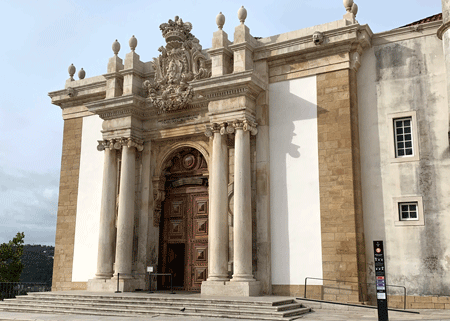
I must say, the Biblioteca Joanina, built in 1717, was pretty darn impressive. The University has a tight control on library visitors, with only 50 people allowed in at a time, for a closely monitored 20 minutes. And no pictures are allowed – at all.
Three Hundred Thousand Books

visual of old books
We were ushered in under close watch. Shelves towered over us, three stories high on all sides, filled with 300 thousand books dating from the 16th to 18th century. I love the look of old books and have ten or twelve at home that were handed down to me from several generations ago, but the books in this library were Old, with a capital “O”. And there were so many.
Protecting the Books
The library, with centuries old, irreplaceable books, was constructed to keep the books in pristine condition. The external walls are 6 feet, 9 inches thick and the enormous door is made of teak. But the most impressive thing are the bats.

A colony of bats live in the library walls, and the University welcomes them to do so. They come out each night and feast on any potentially harmful bugs that might damage the books. Should it occur to you, as it did to me, that the bat droppings could pose a problem, rest assured the staff covers all the plush wool rugs and solid wood carved tables with thick leather blankets each night.
Mammoth Meringues & Savory Bites
Far down the hill from the University and Library, where things flatten out by the Rio Mondegov (River) are several pastry shops with the biggest meringues on earth (probably).
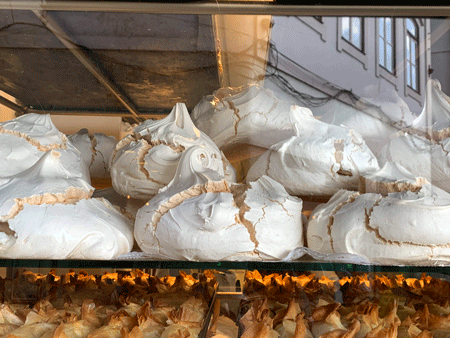
These meringues are so large that I assumed they were loaves of bread. With closer inspection, and after verifying with a bakery employee, I found out they were indeed meringue.
It’s All About Perspective
I didn’t get a good picture showing how large the meringues actually are because Steve refused to pose with them. I’m not sure why – I’m fine posing next to any baked good myself.
I’d say the average meringue measured a foot in diameter and about eight to ten inches high, including peaks. The meringues sold whole or quartered. Even a quarter of a meringue would take days to eat. But it would have been a fun, and perhaps sticky, few days.
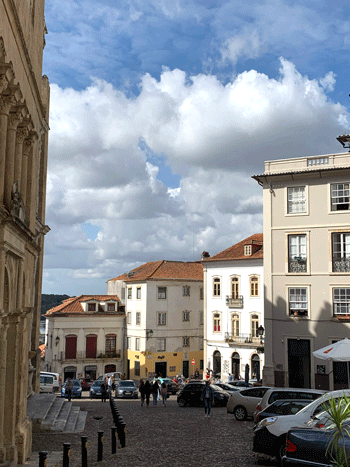
Charming square we frequented in front
of Se Velha Cathedral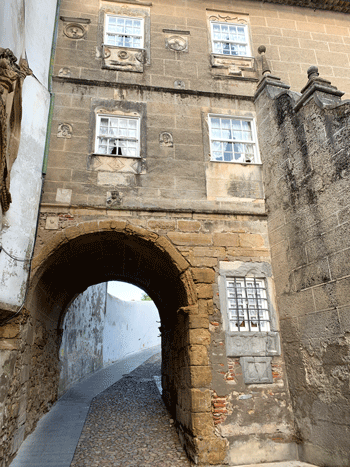
Our route near the apartment
We missed out on trying a meringue, but we did eat (twice) at an incredible restaurant, Maria Portuguesa. Maria Portuguesa, is located about 50 m from the Se Velha Cathedral, and only a 5-6 minute walk from our apartment.
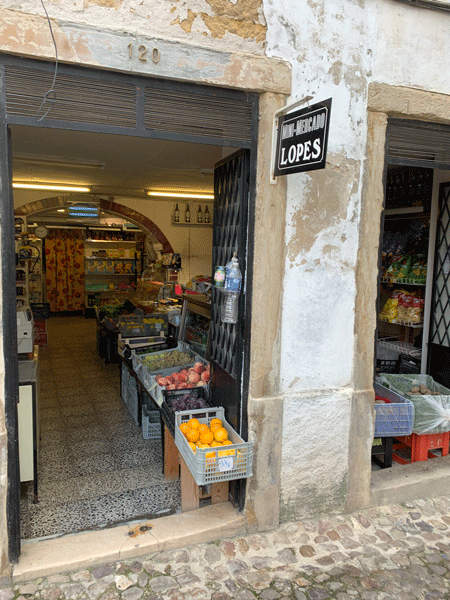
Neighborhood Market where we bought water, fruit & cookies 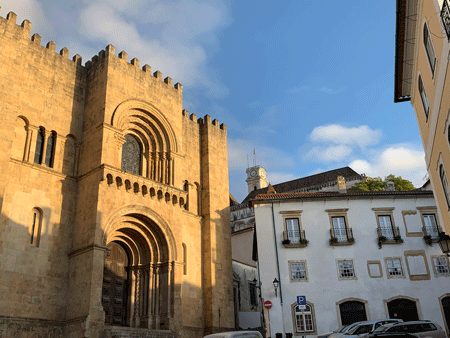
Se Velha Cathedral, near our apartment
The tiny, cozy restaurant has only five proper tables for two, and one little rickety folding table, also for two (there are a few outdoor tables too). The stuffed portabella mushroom, wrapped in bacon (which is like ham in Portugal), was incredible. We had it twice. And the meal was so reasonably priced. Amazing dinner, wine, and sparkling water totaled just over $22 for the two of us.
Other Wanderings
Besides eating, which is always a highlight, we visited the Museu da Ciência da Universidade de Coimbra (Science Museum) and the Museo Zoological.
We also attended a Fado performance (Portuguese traditional music) at Fado ao Centro, and walked all through the historic part of town.
Coimbra, like all the Portuguese towns I’ve visited, is full of red tiled rooftops, black and white tiled sidewalks, unusual architecture, and surprisingly beautiful ironwork balconies.
Museum Nacional de Machado de Castro
I like museums, but Steve loves museums. I try to regulate how many we go to, and how long we will stay. I’m good with two museums a week, and try to stick to a three hour maximum per visit. Well, it turns out the Museum Nacional de Machado de Castro was like two museums in one. Nevertheless, I was happy to make an exception to my rule and stay overtime. It was just that good.
The museum first opened in 1913 in a Bishop’s Palace and housed a great sculpture collection. It closed suddenly in 2008, and no one knew why. During the ten year closure, the Museum Director organized the excavation of an enormous Roman Cryptoporticus and Forum beneath the Bishop’s Palace, dating from the 1st Century AD. Now that’s quite a find!
Cryptoporticus & Forums Explained
For those (like me) who don’t know exactly what a Roman Cryptoporticus and Forum are, let me explain. A Cryptoportico is a semi-subterranean gallery with vaulting that supports the structures above ground, such as a Forum, or central plaza. But because of the ancient nature of the Roman structures, both the Forum and the Cryptoporticus are now underground – in fact, under the Bishop’s Palace.
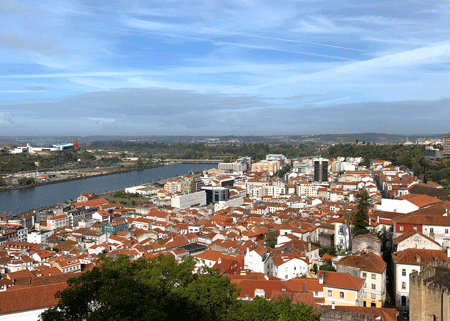
We walked into the Bishop’s Palace Museum, in the heart of historic Coimbra, and paused in the courtyard to admire the sweeping view of the city.
Down You Go
The museum personnel directed us down the stairs into the depths underneath the Palace. Landing in a deep, arched vault made of stone, all in shades of white and beige, was quite a contrast to the colorful Portugal above. The arched hallways, paths, and rooms, all made of stone blocks, are beautifully lit. It was like walking around in an ancient tomb, but with good lighting. Even I, at 5’3”, would duck down to get through most of the arched doors that led from one room to the next.
After the Cryptoporticus and Forum, the sculptures in the upper floors did not disappoint. Some of the sculptures had such life-like features, it was hard to pull my eyes away.
Wins and Losses
Wins
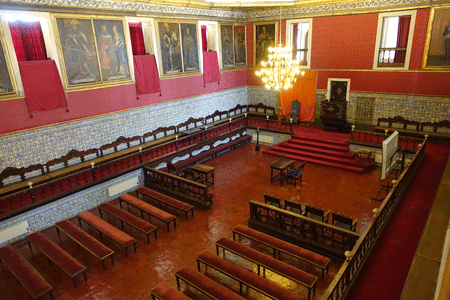
under the chandelier in this imposing room

Never, ever, having to defend a dissertation in the “hot seat” at Coimbra University, in the middle of the enormous, imposing red room, surrounded by portraits of all the former kings of Portugal – not to mention the University faculty.
We finally figured out that the little fox graffiti figure we’ve been seeing all over Portugal is actually an anti-government symbol. Ruh-Roh.
Not going to museum-jail after being chased down by several Museum attendants (as we were leaving), who were overly concerned that we hadn’t hit every single floor and seen every single exhibit.
Losses
Not taking the plunge and buying a giant meringue. Opportunity lost!
Getting the same grumpy, impatient, Portuguese mumbling Uber driver both times we Ubered, twice in the same day.
